On safari in East Africa - Is it everything it's cracked up to be?
Gavin Brown, one of our esteemed 'safari designers' (aka travel consultants), joined the club and visited Tanzania on an educational safari in June. I was very impatient to chat to him about his trip and see his pics (Tanzania is SO on my bucket list!). More than anything, I wanted to know whether: a) it lived up to his expectations, and b) how it compares to other safari destinations – particularly those in the south.
Alison: "Hi Gavin, how did you like Tarangire National Park – your first safari stop from Arusha?"
Gavin: "I was impressed and see why it's on our radar when guests enquire about East African safaris. Its close proximity to Arusha, Ngorongoro Crater, and Serengeti makes it a popular option. It is known for huge herds of elephants and, between June and November which is the dry season, the elephants go to the Silale Swamp which still has water in the dry months. We could already see big herds of elephants in the swamp area which is more like a vlei."
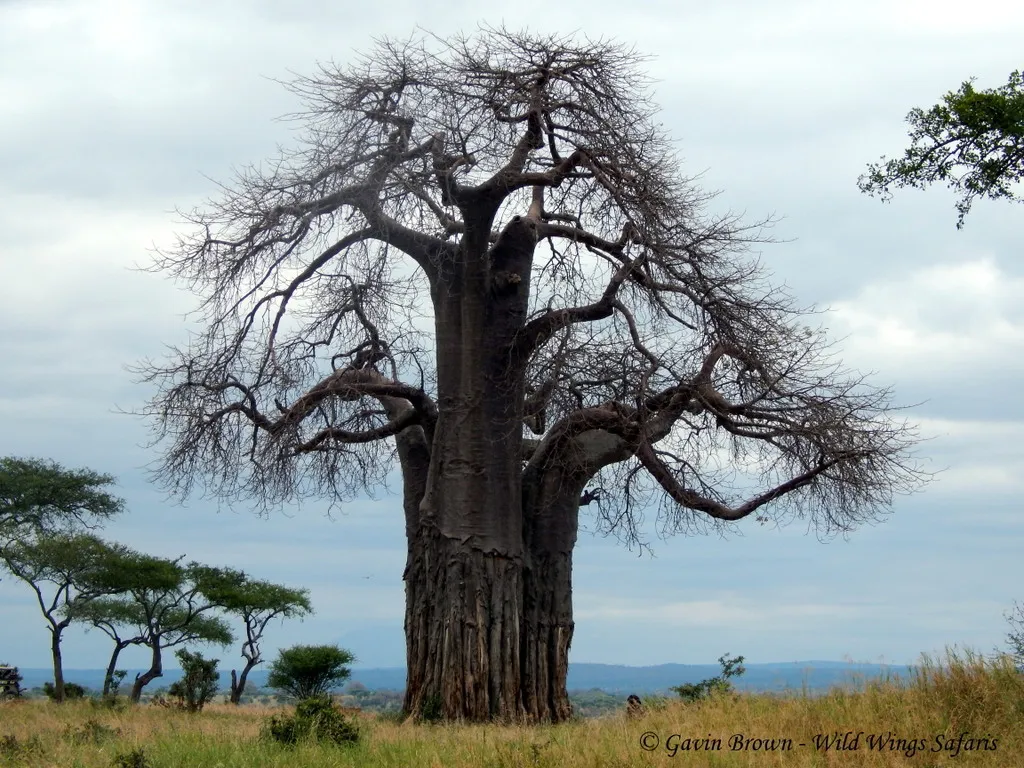
Ancient baobabs,Tarangire
"The birdlife is prolific. There's a large variety of species, including birds of prey. Just spectacular. In June/July there's a mini-migration of zebra from Lake Manyara to Tarangire (which has water all year round). We saw herds of zebra, plenty of elephant, a herd of 200 buffalo, waterbuck, dik-dik, jackals, and lion.
Rainy season in Tarangire is from November until May, with March and April recording the highest rainfall. It's really an all year round safari destination. You could stay outside the park but - just as with the Kruger – it's much nicer being inside."
Alison: "What about Lake Manyara National Park?"
Gavin: "It was great to see the place of the famous tree-climbing lions that the others had told me about. They spend most of the day chilling out on the branches of Acacia trees. It's also known for its flamingos. It's very beautiful with different vegetation which makes it interesting. It's a small national park that can be covered in a day - or even half a day if time is an issue."
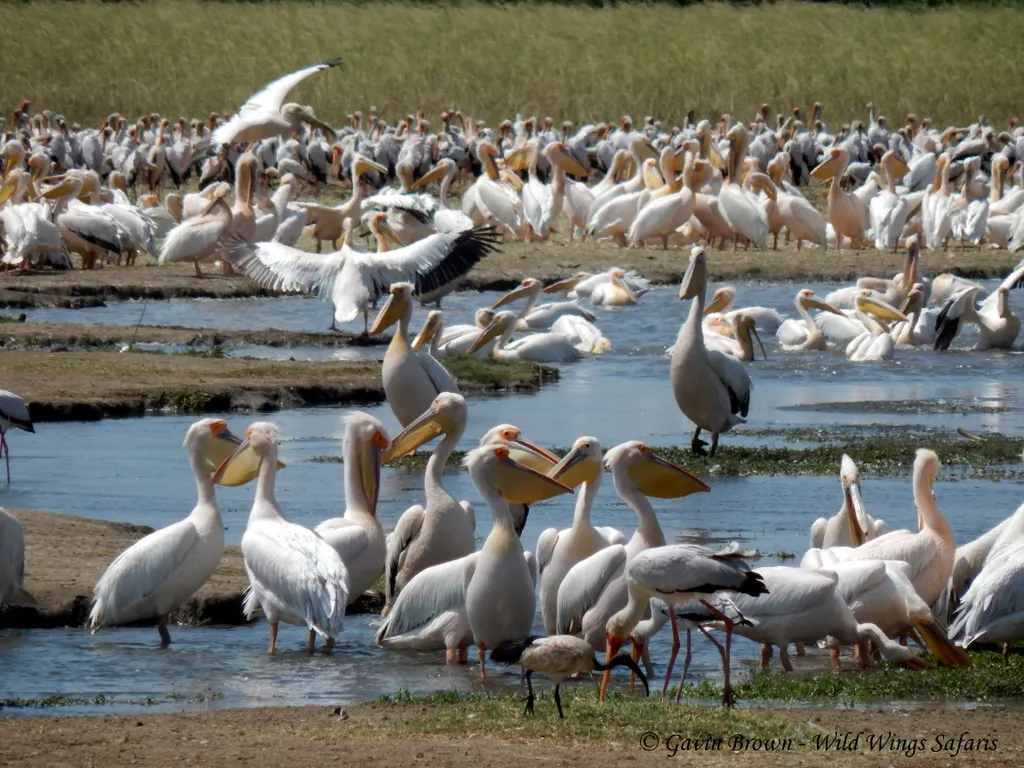
Pelicans, Lake Manyara
"We saw huge troops of baboons, blue monkeys, flamingos (they visit in June, July, and August) thousands of yellow-billed storks and greater pelicans as well as marabou storks, cranes, and hippos."
Alison: "And the famous Ngorongoro Crater?"
Gavin: "Have to agree that this World Heritage Site is a game viewing Eden. It's supposedly home to some 30,000 animals, half of which are wildebeest and zebra. The soil on the crater floor is rich and fertile, so there's plenty of grazing for the animals. Thanks to anti-poaching patrols, it's also one of the few places in East Africa where you're likely to see black rhino.
There's also a chance to see Maasai tribesmen with their cattle (although we weren't lucky enough), showing that wild and domesticated animals are known to co-exist."
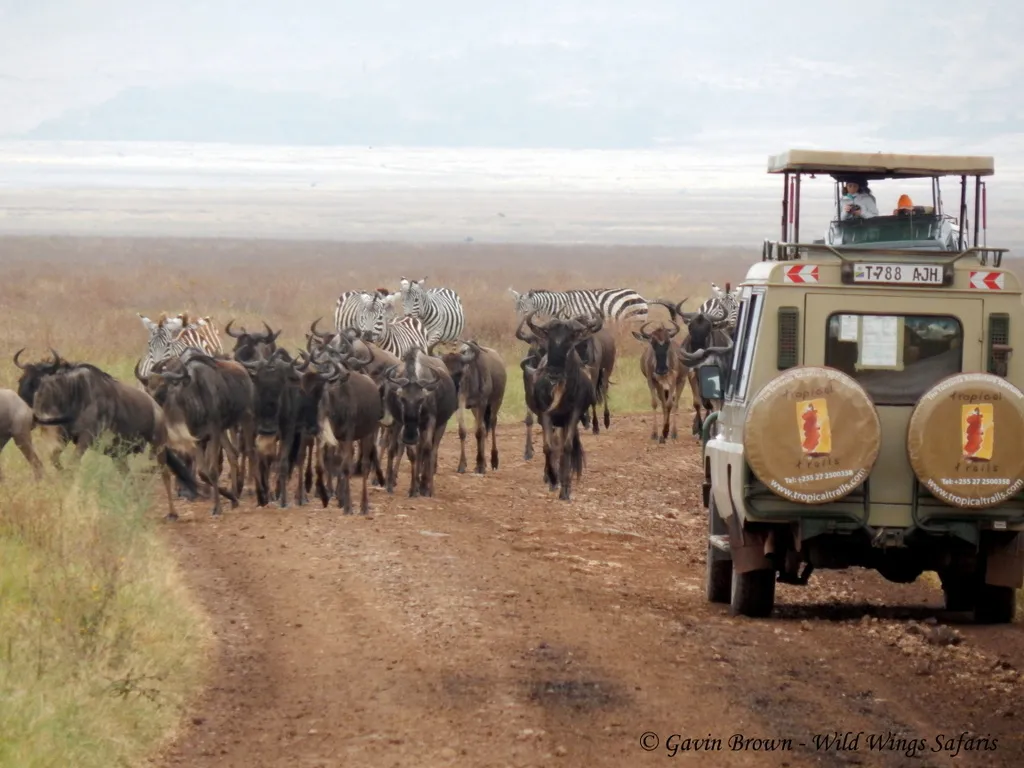
Ngorongoro Crater
"We saw lion, significant zebra, wildebeest and buffalo herds as well as Thomson and Grant gazelles, spotted hyena, and a variety of other game. Game is plentiful, and so are the tourists so you can see up to 20 -30 vehicles at a lion sighting, for example. Ngorongoro Crater is spectacular in every way."
Alison: "How did you like the Serengeti National Park?"
Gavin: "It's every bit as amazing as the others had told me it would be. It has to be my favourite safari destination. The migration is always happening. I think people have got the wrong idea from National Geographic and other media that the migration is only about the wildebeest crossing of the Grumeti and Mara Rivers."
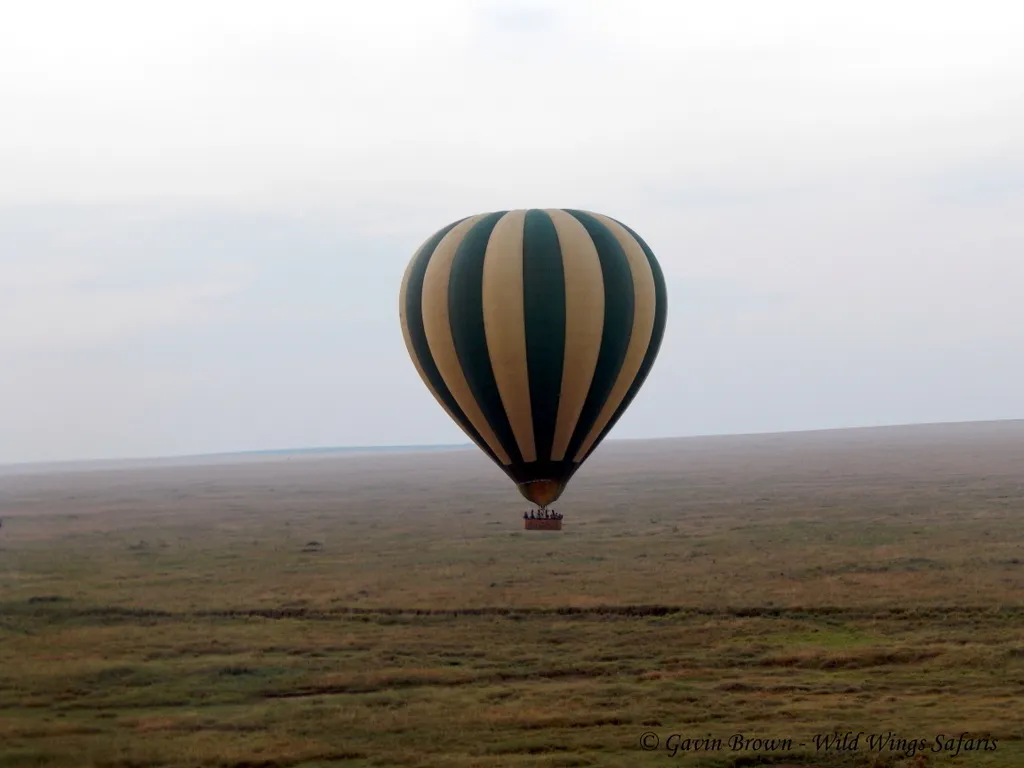
Ballooning, Serengeti
"There is far much more to the migration. It's not an exact science. For example, the week before we arrived, the migration herd was meant to move from the Seronera [central area of Serengeti] to the western corridor, but they decided to go north instead. Then quite unexpectedly, it rained in the Seronera (which is not seasonal in mid-June) and about half the herd came back, which fortunately coincided with our safari and was amazing.
It seems that it's never easy to predict the timing of the migration. It's a phenomenon that has to do with the availability of food and water; this is what motivates the herd to move."
Alison: "What would you say are the major differences? East vs South?"
Gavin: "As I'd heard, Tanzanian safari lodges seem to work a little differently from their southern counterparts. They don't have their own vehicles, nor do they offer game drives. Rather, you get your own guide with his own vehicle who will do all your game drives and, often, your whole safari. So the quality of your guide is super important.
Park fees in Tanzania also seem quite expensive, ranging from US$ 40 – 60 per person per day. Plus there's an additional camp fee of US$50 per person per day if you're staying at a tented camp.
The daily safari schedule also differs. Here, we do early morning game drives, then back for a hearty brunch. There, they breakfast first then get out on the road by 8 am. The norm seems to be to return to the lodge or tented camp for lunch and a short siesta before the afternoon game drive."
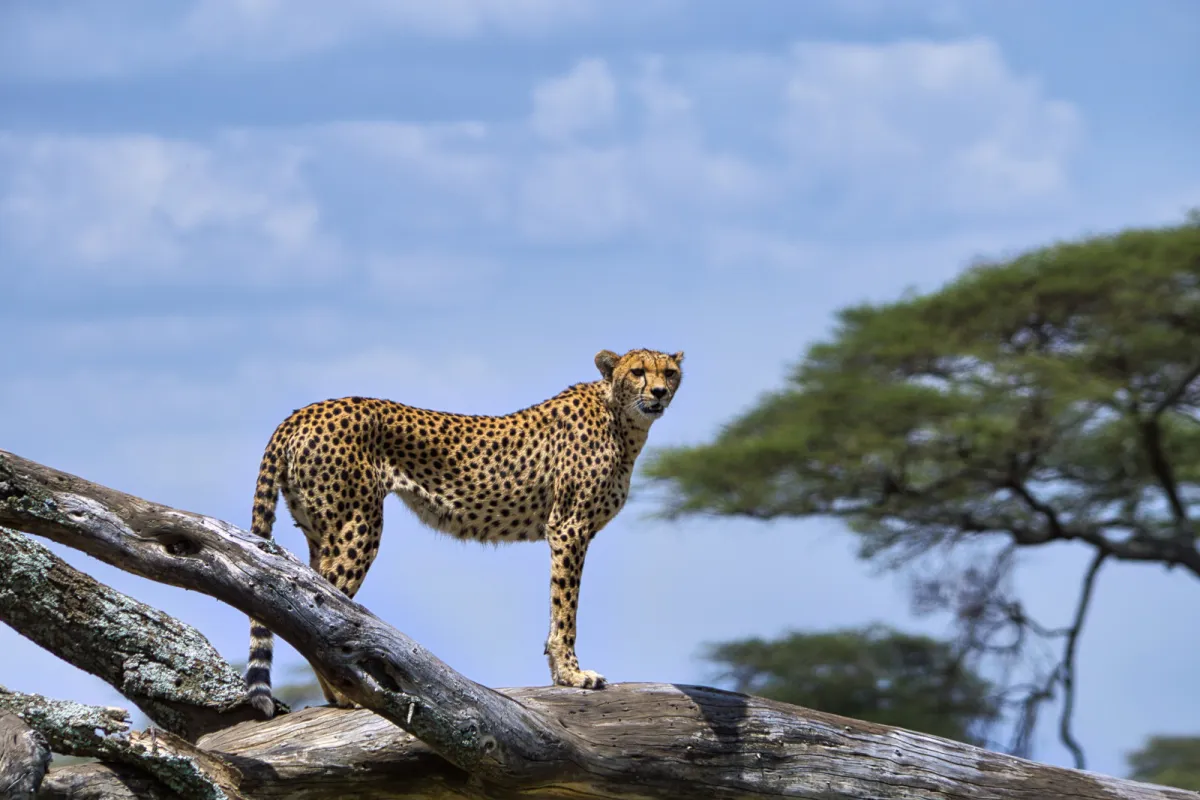
Serengeti cheetah
"Going on safari in Tanzania is real Africa: travelling is rough in places and dusty and remote but for the safari enthusiast, it's a world-class experience."
Alison: "What were your highlights?"
Gavin: "It was very special staying at a tented camp, being surrounded by herds of wildebeest throughout the night, and hearing lions and hyenas close by. In fact, while we were having dinner one night, a herd stampeded past the mess tent; it lasted about a minute. It was incredible.
I was amazed at the food that came out of the bush kitchens, it was delicious.
Seeing migration herds in the Serengeti, driving for miles and miles through herds of wildebeest and zebra, on a scale that I have never seen before.
A hot air balloon ride in the Serengeti and seeing the migration herds from the air and getting a sense of the wide-open grasslands that seem to stretch on forever."
Alison: "What type of safari would you suggest – tented or lodge/hotel?"
Gavin: "In the Serengeti, I feel that it would not be complete without experiencing tented accommodation, even if it's just for one night. I know some people have strong aversions to bugs and insects, but I would never have experienced what I did if I had only stayed in a lodge."
Alison: "And your conclusions?"
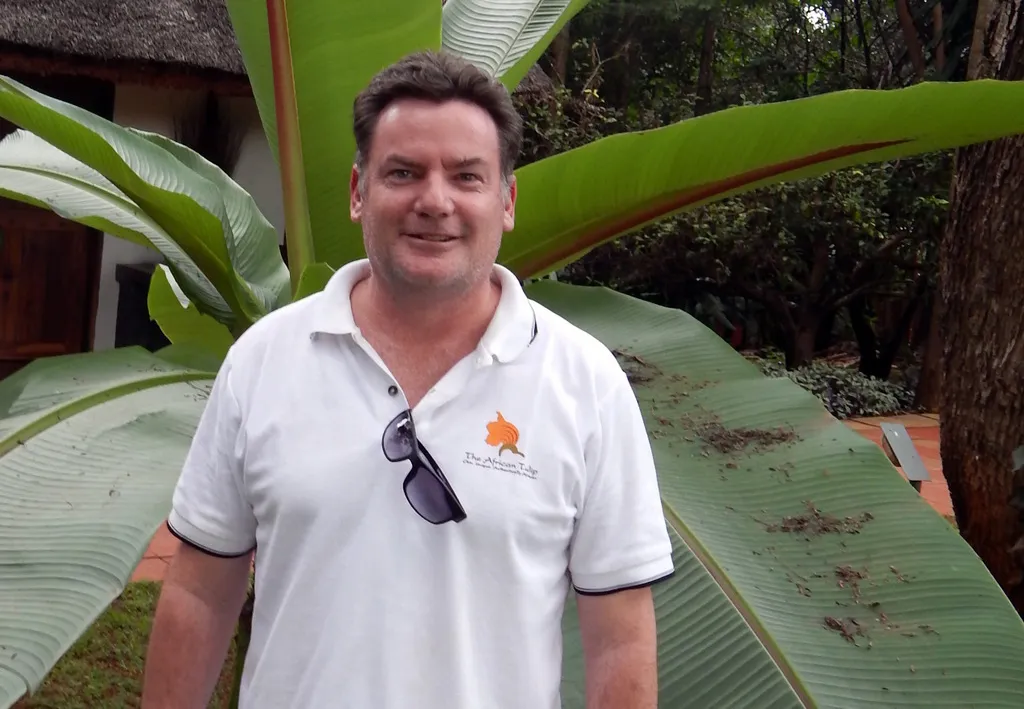
Gavin Brown
Gavin: "I can now see why East Africa is a world-class safari destination. Personally, I have never experienced a safari like I did in the Serengeti and I look forward to also being able to recommend it to our overseas guests."
So there you have it. Fresh from a seasoned safari-goer who - like all Wild Wings' travel experts - has visited many, many safari reserves, lodges and properties over the years. Personally, I'll take his word for it. And East Africa's just moved up several notches on my bucket list!
Have you done both southern and east African safaris with us before? Or on your own? What did you prefer? And what did you find most different about them? Please share with us in the comments below.
UPDATE: Check out some of our East African safaris, awesome safari lodges, hotels and tented camps, exciting trip ideas, and the various safari destinations here:
Kenya Travel Guide
If you have any queries about East Africa, please contact us for more info now.
You may also want to look at

5 Day Luxury Serengeti Safari
Explore one of the Serengeti's most exclusive regions on this 5-day luxury fly-in safari. Based at Olmara Camp in the Soit le Motonyi area of eastern Serengeti, you'll experience exceptional game viewing in a remote, low-tourist zone known for its high concentration of big cats. This safari includes a scenic domestic flight from Kilimanjaro International Airport near Arusha to Seronera Airstrip in the central Serengeti, four nights in an eco-luxury tented camp, and expertly guided game drives in a wildlife-rich area once closed to tourists.
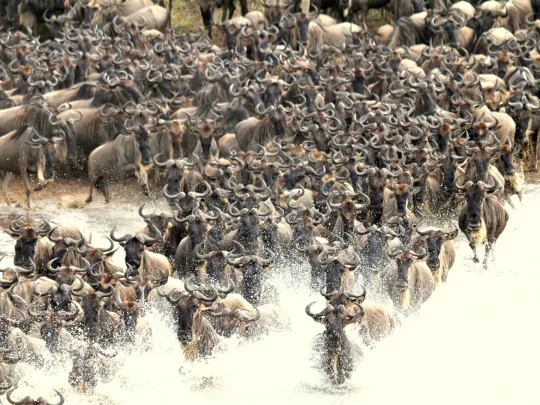
7 Day Taste of Tanzania Safari Tour
This expertly guided 7-day Tanzania safari showcases the very best of northern Tanzania's wildlife reserves. From the baobab-studded plains of Tarangire to the lush highlands of Ngorongoro Crater and the endless grasslands of the Serengeti, this safari promises close-up encounters with Africa's most iconic species. Depending on the season, you may even witness the Great Migration, one of the world's most spectacular natural events.

14 Day Tanzania Bush & Beach Adventure
Experience untamed Africa like never before with a journey through Tanzania's Southern Safari Circuit—a hidden gem offering authentic wildlife encounters far from the bustling crowds of the Northern Circuit. This uncrowded and unspoiled region features the beautiful game reserves of Ruaha, Katavi, and Selous (Nyerere National Park). Finish your adventure with five blissful days at a private tropical island paradise.
About the author

A 'word smith' or copywriter with over 25 years experience, love travelling, wildlife and conservation; fascinated by alternative energy, alternative building and alternative health. Consummate reader and traveller, both internationally and southern Africa. Have two remarkable daughters that continue to amaze and teach me daily. Consider myself privileged to live on the best continent on the planet.









